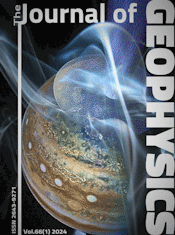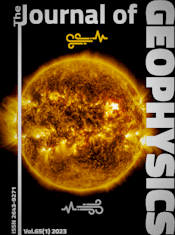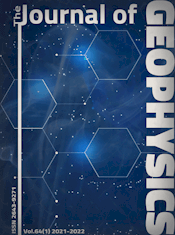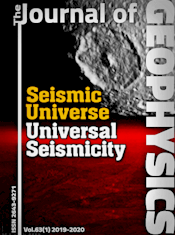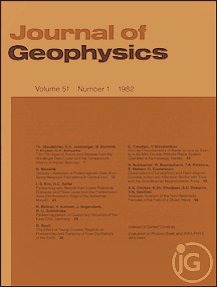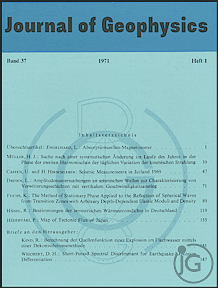A continuum model of crustal generation in Iceland - kinematic aspects
Article Sidebar

Vols. 1-18 (1924-1944), ISSN 0044-2801
Main Article Content
Abstract
A steady-state plate-tectonic kinematic model of crustal accretion in Iceland is presented. It describes quantitatively the overall time-averaged movements of solid crustal elements during the accretion process, and correlates accretion parameters in the axial zone (width of lava deposition zone, total lava production rate, width of horizontal strain zone, spreading velocity, normal faulting) with structural properties in the Tertiary lava pile (lava dips, lava deposition rate, dyke fraction). The model is used, firstly, to predict the accretion parameters of the Tertiary volcanic zone on the basis of observed structural properties in the Tertiary lava pile; secondly, to predict possible structures of the lower crust in terms of a lava/intrusion ratio; thirdly, the model may be used to calculate the crustal temperature field caused by intrusions, but this application is outside the scope of the present paper. The model is essentially a further development of a previous one presented earlier by the author. The analysis, in terms of the model, of various published structural observations indicates that the width of lava deposition and the spreading rate in the Tertiary volcanic zone were consistent with the corresponding properties in the present-day volcanic zone. This may suggest a certain uniformity in the volcanic processes during the last 10-15 Ma. The visible Tertiary lava pile was, according to the model, deposited outside the innermost 50-km-wide central part of the volcanic zone, which may explain the difference in appearance between the two main volcanic regions of Iceland, i.e., the active volcanic zone and the Tertiary flood basalts. Furthermore, an analysis of possible structures of the lower crust, consistent with various surface observations, indicates a gradual rather than a sharp transition from an upper lava-dominated crust to a lower intrusion-dominated crust.
 ARK: https://n2t.net/ark:/88439/y050901
ARK: https://n2t.net/ark:/88439/y050901
Permalink: https://geophysicsjournal.com/article/69
Article Details
References
Atwater, T., Mudie, J.D. (1973) Detailed near-bottom geophysical study of the Gorda Rise. J. Geophys. Res. 78:8665-8686
Bjornsson, A., Saemundsson, K., Einarsson, P., Tryggvason, E., Gronvold, K. (1977) Current rifting episode in north Iceland. Nature 266:318-322
Bodvarsson, G., Walker, G.P.L. (1964) Crustal drift in Iceland. Geophys. J.R. Astron. Soc. 8:285-300
Cann, J.R. (1974) A model for the oceanic crustal structure developed. Geophys. J.R. Astron. Soc. 39:169-187
Daignieres, M., Courtillot, V., Bayer, R., Tapponnier, P. (1975) A model for the evolution of the axial zone of mid-ocean ridges as suggested by Icelandic tectonics. Earth Planet. Sci. Lett. 26:222-232
Harrison, C.G.A. (1968) Formation of magnetic anomaly patterns by dyke injection. J. Geophys. Res. 73:2137-2142
Herron, E.M., Talwani, M. (1972) Magnetic anomalies on the Reykjanes Ridge. Nature 238:390-392
Jakobsson, S.P. (1972) Chemistry and distribution pattern of Recent basaltic rocks in Iceland. Lithos 5:365-386
Johannesson, H. (1975) Structure and petrochemistry of the Reykjadalur central volcano and the surrounding areas, midwest Iceland. Ph.D. Thesis. Durham University, 273 pp.
Kidd, R.G.W. (1977) A model for the process of formation of the upper oceanic crust. Geophys. J .R. Astron. Soc. 50:149-183
Matthews, D.H., Bath, J. (1967) Formation of magnetic anomaly pattern of mid-Atlantic ridge. Geophys. J.R. Astron. Soc. 13:349-357
McDougall, I., Saemundsson, K., Johannesson, H., Watkins, N.D., Kristjansson, L. (1977) Extension of the geomagnetic polarity time scale to 6.5 m.y.: K-Ar dating, geological and paleomagnetic study of a 3,500 m lava succession in western Iceland. Geol. Soc. Am. Bull. 88:1-15
McDougall, I., Watkins, N.D., Kristjansson, L. (1976a) Geochronology and paleomagnetism of a Miocene-Pliocene lava sequence at Bessastadaa, eastern Iceland. Am. J. Sci. 276:1078-1095
McDougall, I., Watkins, N.D., Walker, G.P.L., Kristjansson, L. (1976b) Potassium-argon and paleomagnetic analysis of Icelandic lava flows: Limits on the age of anomaly 5. J. Geophys. Res. 81:1505-1512
Needham, H.D., Francheteau, J. (1974) Some characteristics of the rift valley in the Atlantic Ocean near 36° 48' north. Earth Planet. Sci. Lett. 22:29-43
Palmason, G. (1973) Kinematics and heat flow in a volcanic rift zone, with application to Iceland. Geophys. J. R. Astron. Soc. 33:451-481
Ross, J.G., Mussett, A.E. (1976) 40Arj3 9Ar dates for spreading rates in eastern Iceland. Nature 259:36-38
Saemundsson, K. (1967) Vulkanismus und Tektonik des Hengili-Gebietes in SiidwestLisland. Acta Nat. lsi. II (7), 195 pp.
Tapponnier, P., Francheteau, J. (1978) Necking of the lithosphere and the mechanics of slowly accreting plate boundaries. J. Geophys. Res. 83:3955-3970
Walker, G.P.L. (1959) Geology of the Reydarfjordur area, eastern Iceland. Q. J. Geol. Soc. London 114:367-391
Walker, G.P.L. (1960) Zeolite zones and dyke distribution in relation to the structure of the basalts in eastern Iceland. J. Geol. 68:515-528
Walker, G.P.L. (1974) The structure of eastern Iceland. In: Geodynamics of Iceland and the North Atlantic Area, L. Kristjansson, ed.: pp.177-188. Dordrecht: Reidel
Watkins, N.D., Walker, G.P.L. (1977) Magnetostratigraphy of eastern Iceland. Am. J. Sci. 227:513-584



